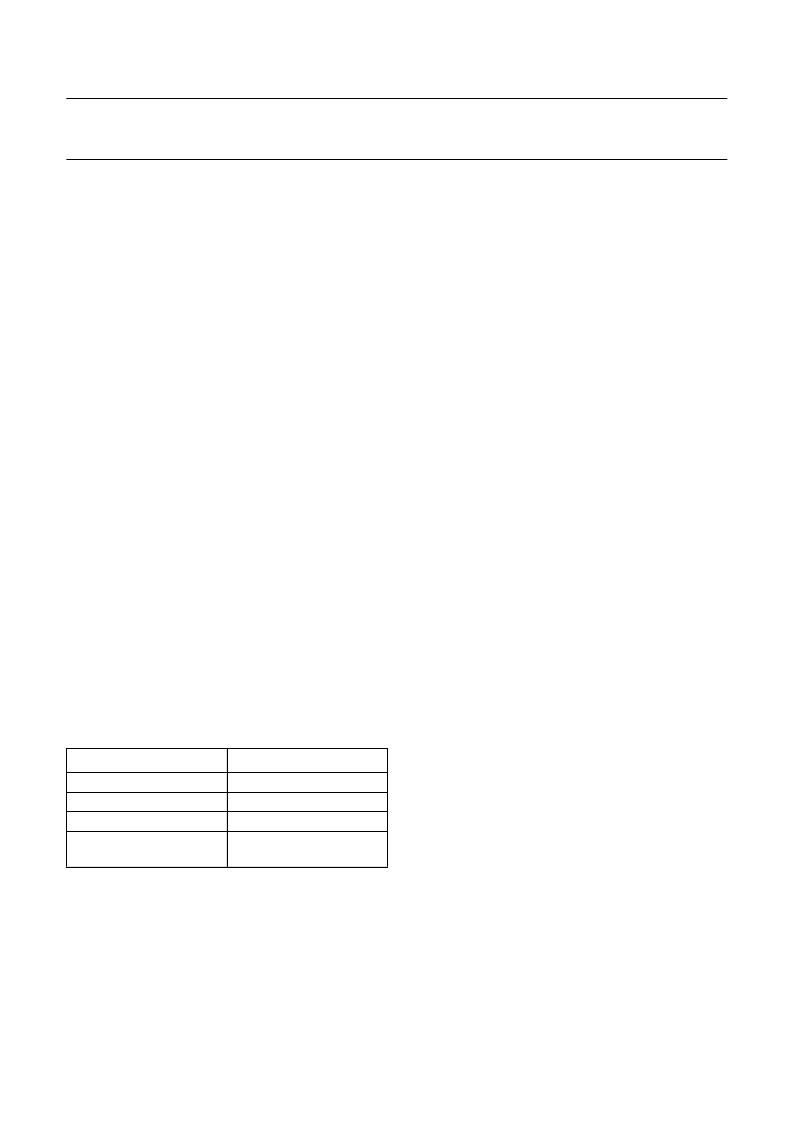- 您現(xiàn)在的位置:買(mǎi)賣(mài)IC網(wǎng) > PDF目錄382381 > PCF2105MU (NXP Semiconductors N.V.) LCD controller/driver PDF資料下載
參數(shù)資料
| 型號(hào): | PCF2105MU |
| 廠(chǎng)商: | NXP Semiconductors N.V. |
| 英文描述: | LCD controller/driver |
| 中文描述: | LCD控制器/驅(qū)動(dòng)器 |
| 文件頁(yè)數(shù): | 19/48頁(yè) |
| 文件大小: | 289K |
| 代理商: | PCF2105MU |
第1頁(yè)第2頁(yè)第3頁(yè)第4頁(yè)第5頁(yè)第6頁(yè)第7頁(yè)第8頁(yè)第9頁(yè)第10頁(yè)第11頁(yè)第12頁(yè)第13頁(yè)第14頁(yè)第15頁(yè)第16頁(yè)第17頁(yè)第18頁(yè)當(dāng)前第19頁(yè)第20頁(yè)第21頁(yè)第22頁(yè)第23頁(yè)第24頁(yè)第25頁(yè)第26頁(yè)第27頁(yè)第28頁(yè)第29頁(yè)第30頁(yè)第31頁(yè)第32頁(yè)第33頁(yè)第34頁(yè)第35頁(yè)第36頁(yè)第37頁(yè)第38頁(yè)第39頁(yè)第40頁(yè)第41頁(yè)第42頁(yè)第43頁(yè)第44頁(yè)第45頁(yè)第46頁(yè)第47頁(yè)第48頁(yè)

1998 Jul 30
19
Philips Semiconductors
Product specification
LCD controller/driver
PCF2105
9.6
Function set
9.6.1
DL (
PARALLEL MODE ONLY
)
Bit DL sets the interface data length. Data is sent or
received in bytes (DB7 to DB0) when DL = 1 or in two
nibbles (DB7 to DB4) when DL = 0. When 4-bit length is
selected, data is transmitted in two cycles using the
parallel bus. In a 4-bit application DB3 to DB0 are left open
(internal pull-ups).
DL can not be set to logic 0 from the I
2
C-bus interface.
If DL has been set to logic 0 via the parallel bus,
programming via the I
2
C-bus interface is complicated.
9.6.2
N
AND
M
Bits N and M set the number of display lines.
9.7
Set CGRAM address
‘Set CGRAM address’ sets bits 0 to 5 of the CGRAM
address (A
CG
in Table 3) into the AC (binary A[5] to A[0]).
Data can then be written to or read from the CGRAM.
Only bits 0 to 5 of the CGRAM address are set by the ‘set
CGRAM address’ instruction. Bit 6 can be set using the
‘set DDRAM address’ instruction or by using the
auto-increment feature during CGRAM write. All bits 0 to 6
can be read using the ‘read busy flag and address’
instruction.
9.8
Set DDRAM address
‘Set DDRAM address’ sets the DDRAM address (A
DD
in
Table 3) into the AC (binary A[6] to A[0]). Data can then be
written to or read from the DDRAM.
Table 5
Hexadecimal address ranges
ADDRESS
FUNCTION
00 to 4F
00 to 0B and 0C to 4F
00 to 27 and 40 to 67
00 to 13, 20 to 33, 40 to 53
and 60 to 73
1 line of 24 characters
2 lines of 12 characters
2 lines of 24 characters
4 lines of 12 characters
9.9
Read busy flag and address
‘Read busy flag and address’ reads the Busy Fag (BF).
When bit BF = 1 it indicates that an internal operation is in
progress. The next instruction will not be executed until
BF = 0, so BF should be checked before sending another
instruction.
At the same time, the value of the AC expressed in binary
A[6] to A[0] is read out. The address counter is used by
both CGRAM and DDRAM and its value is determined by
the previous instruction.
9.10
Write data to CGRAM or DDRAM
‘Write data’ writes binary 8-bit data (D[7] to D[0]) to the
CGRAM or the DDRAM.
Whether the CGRAM or DDRAM is to be written to is
determined by the previous specification of CGRAM or
DDRAM address setting. After writing, the address
automatically increments or decrements by 1, in
accordance with the ‘entry mode set‘.
Only bits D[4] to D[0] of CGRAM data are valid,
bits D[7] to D[5] are ‘don’t care’.
9.11
Read data from CGRAM or DDRAM
‘Read data’ reads binary 8-bit data D[7] to D[0] from the
CGRAM or DDRAM.
The most recent ‘set address’ instruction determines
whether the CGRAM or DDRAM is to be read.
The ‘read data’ instruction gates the content of the
Data Register (DR) to the bus while pad E = HIGH. After E
goes LOW again, internal operation increments
(or decrements) the AC and stores RAM data
corresponding to the new AC into the DR.
Remark: the only three instructions that update the DR are:
‘Set CGRAM address’
‘Set DDRAM address’
‘Read data’ from CGRAM or DDRAM.
Other instructions (e.g. ‘write data’, ‘cursor/display shift’,
‘clear display’, ‘return home’) will not change the data
register content.
相關(guān)PDF資料 |
PDF描述 |
|---|---|
| PCF26100 | Bluetooth Adapter IC |
| PCF26100ET | DVI_D - DVI_D SINGLE LINK CABLE 5M BLK RoHS Compliant: Yes |
| PCF3F10B | Analog IC |
| PCF3F160 | Analog IC |
| PCF3F30 | Analog IC |
相關(guān)代理商/技術(shù)參數(shù) |
參數(shù)描述 |
|---|---|
| PCF2105MU/2 | 制造商:PHILIPS 制造商全稱(chēng):NXP Semiconductors 功能描述:LCD controller/driver |
| PCF2105MU/7 | 制造商:未知廠(chǎng)家 制造商全稱(chēng):未知廠(chǎng)家 功能描述:LCD Display Driver |
| PCF210AA | 制造商:PHILIPS 制造商全稱(chēng):NXP Semiconductors 功能描述:SPI Real time clock/calendar Time keeping application |
| PCF2110 | 制造商:未知廠(chǎng)家 制造商全稱(chēng):未知廠(chǎng)家 功能描述:LCD Display Driver |
| PCF2111 | 制造商:PHILIPS 制造商全稱(chēng):NXP Semiconductors 功能描述:LCD drivers |
發(fā)布緊急采購(gòu),3分鐘左右您將得到回復(fù)。